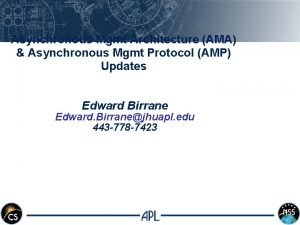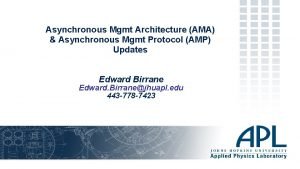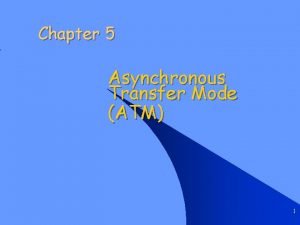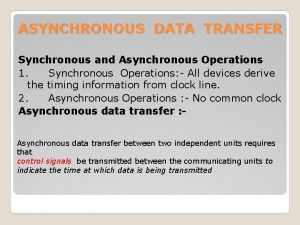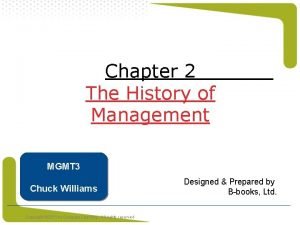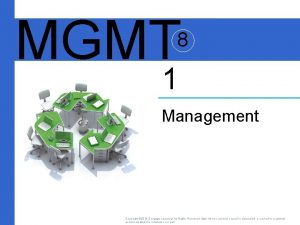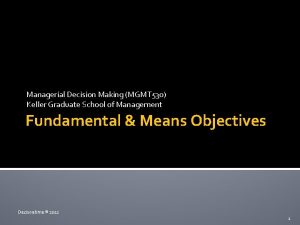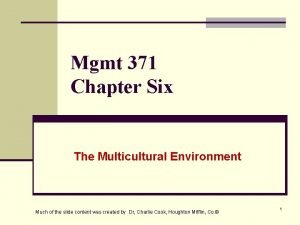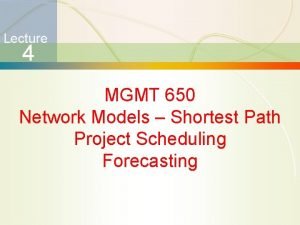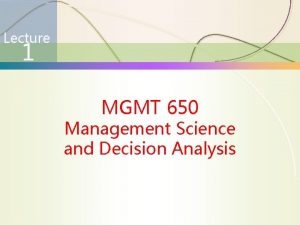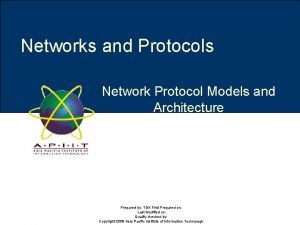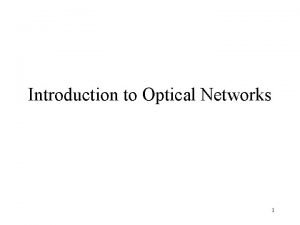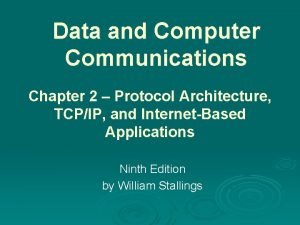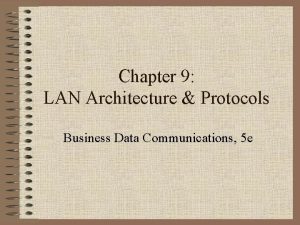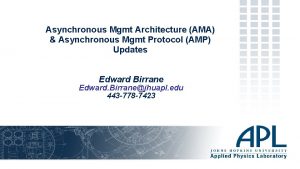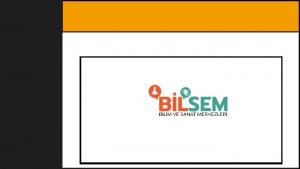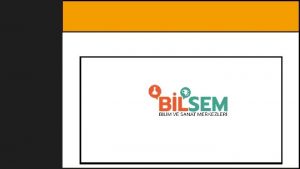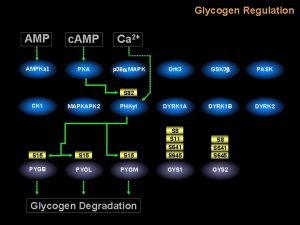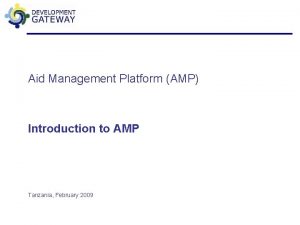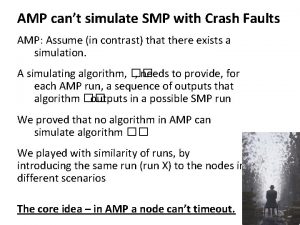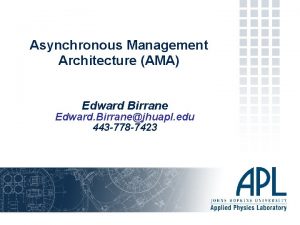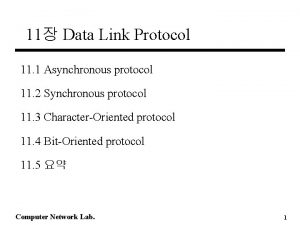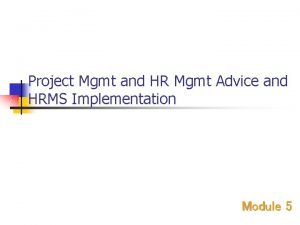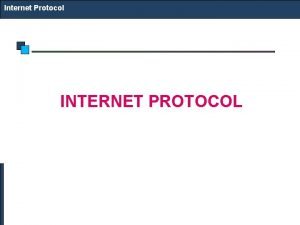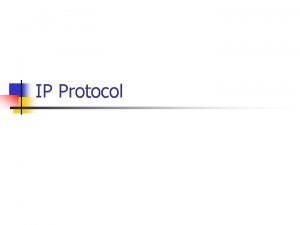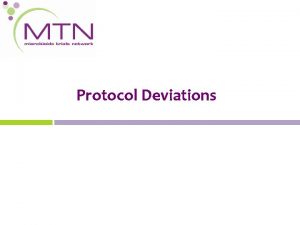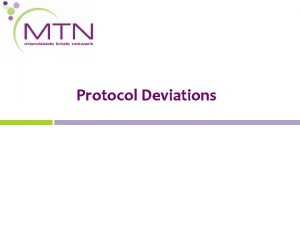Asynchronous Mgmt Architecture AMA Asynchronous Mgmt Protocol AMP
























- Slides: 24

Asynchronous Mgmt Architecture (AMA) & Asynchronous Mgmt Protocol (AMP) Updates Edward Birrane Edward. Birrane@jhuapl. edu 443 -778 -7423

Agenda § Background q Motivation, Timeline, Vision § AMA Overview and Updates q q q Service Definitions, Desirable Properties Core concept, logical: ADM Current Status § ADM Overview and Updates q q Concept of overarching Data Model Current Status § AMP Overview and Updates q q Core concept, physical: MID Current Status

Motivation We cannot deploy challenged internetworks until we can manage them. − Use cases for DTNs are emerging: – Handle signal propagation delay (space and some underwater). – – Handle frequent link disruptions. – – Mostly for disaster and some vehicular scenarios. Handle frequent link-access disruptions. – – – Mostly for space and underwater scenarios Mostly for oversubscribed/congested links. Link removed as matter of policy/administration and not physics. All preclude human-in-the-loop network management – – – Nodes operate on “far side” of delayed/disrupted links. Disruptions occur from attenuation, tasking, power, and pointing Network management starts looking more like fault management. Ø Maintain ability to relay information from critical assets both on-board and remotely without access to direct operator intervention.

Timeline - Examined uniqueness of the problem, 2011 -2013 Some early pubs defining the problem as related to DTN - - At that time, SNMP, NETCONF, RMON not sufficient Reviewed popular engineering approaches - Autonomous fault protection schemes, Mobile code/scripting schemes, rule-based, etc. - Delay-Tolerant Network Management Protocol (DTNMP) 2013 Published to DTNRG, Initial implementation by NASA Utility outside of NASA network management - Renamed as Asynchronous Management Protocol (AMP) 2015 Submitted as set of IDs to DTNWG. Initial implementation published in the ION open-source code-base - Some discussion with OPS area members looking at RESTful interfaces. 2016 Focus on an asynchronous data model 4

Vision - A definition/architecture to asynchronously manage resources - Accepting autonomy where challenged deployments require autonomy Extensible, where new applications or protocols can be added without much ado The AMA attempts to address this. - A common data model that can be implemented by a variety of devices - Supporting bit-efficiency where necessary Independent of transport protocol, but perhaps highly useful for DTN The ADM template and individua ADMs attempts to address this - A protocol suitable for resource constrained systems - Where appropriate, re-usable in more richly resourced systems Bit and bandwidth efficient. Designed to limit round-trip comms. The AMP attempts to address this 5

Vision 6

AMA: Overview § Service Definitions q q Configuration: Change settings on an Agent manually or autonomously. Reporting: Receive performance information from an Agent. Autonomous Parameterized Control: Change Agent Behavior based on local time/state. Administration: Fine-grained access to abilities. § Desirable Properties q q q Intelligent Information Push: Can’t rely on others to know what to ask for. Minimize Message Size: Increase probability of delivery, different payloading schemes. Absolute Data Identification: Pre-shared, global naming when appropriate. Custom Data Definition: Only send what is necessary. Autonomous Operation: Management continues even when managers are not around.

AMA: Roles and Responsibilities

AMA: The Simple System Model From draft-birrane-dtn-ama-03 § Agents q q q Run on Managed Devices Configure/Report on devices Heavy autonomy and parameterized control § Manager(s) q q q Collect/Fuse data from Agents Configure Agent behavior Open-loop control § ADMs q q Well-named Data and Controls Superset of MIB Move to describe them in YANG Preconfiguration reduces msg size

AMA: Status and TODO The AMA appears to be a fairly complete capture of the asynchronous management model. Last several revisions have been largely editorial. § AMA Current Status q q Version -04 published. Minor Terminology and Definitions Updates • • • Mostly wordsmithing based on feedback. Changed some terminology for clarity. Some expanded text around parameterization and motivation for the approach. § AMA TODO q q q Some information re-organization to pull some data out of the AMA document and into an ADM document. Review with other potential stakeholders, including members of the OPS area. Remove legacy references to SNMP for management.

ADM: Common Data Model § “Atomic” Elements q q q Solely defined by their ADM. EDDs: collected by agents. Literals: useful constants. Ops: opcodes for math functions. Ctrls: opcodes for agent behavior. § “Variable” Elements q q q Defined by ADM or by User ADM definitions are immutable. Vars: strong-typed variables, including a type for “expression”. Macro: Ordered set of Ctrls. Rpts: Ordered sets of data Rules: Time or State based autonomy. An ADM defines 9 types of data for each application/protocol managed in the AMA.

ADM Listing § Published ADMs q q AMP Agent ADM • Update to account for TABLE data structure, terminology changes BP ADM • Update to terminology changes. Update for BPBis. q BPSEC ADM q ION ADM • Revisit Rule and Key controls in light of ION ADM. § Emerging ADMs q q • Capture of ION administrative command-line utilities. LTP ADM • Capture of existing LTP instrumentation from ION. CGR ADM • Some work performed by DLR.

ADM: Status and TODO § ADMs Current Status q q q Complete a refresh of ADMs to standardize on terminology Incorporate TABLE structure type Migrate existing ADMs to YANG. • With eye towards CBOR encoding § ADM TODO q Extract ADM specification from the AMA and AMP documents and publish an ADM document and associated template. • • q Detail data model items (EDDs, VARs, etc…) and guidance on what to use for what data. Discussion on naming of ADM elements. Registry of ADM identifiers.

AMP: Overview AMP being evaluated by space and non-space users. NASA providing an opensource reference implementation in ION. § Protocol conformant to the architecture/requirements of AMA. q q Implements Agents, Managers, ADM structures. Defines specific data models to implement AMA structures Defines messages to capture AMA controls/reports/administration Defines on-the-wire encodings § Data Models q q Basic Types: Numeric types, strings, etc… Compound Types: BLOBs, (Typed) Data Collections, Tables, Identifiers, Collections, Expressions, Predicates § Functional Specification q q AMP Message Groups: Common headers and trailers Three messages: Register. Agent, Perform. Control, Data. Report

AMP: Updates (1/2) From -02 to -03 § Minor Terminology and Definitions Updates q q Wordsmithing based on feedback. Reduced redundancy between AMP and AMA specs. § Clarifications q q q q Clarified Report Templates vs Report Entries vs Reports. Clarified State vs Time-based Rules. Corrected AMP Epoch time. Added rationale for design of TDCs. Clarified that OID Nicknames are registered values. Clarified OID Parameterization Approach Clarified definition of Variables and their initializing expression.

AMP: Updates (2/2) From -02 to -03 § Additions/Updates q q q q Added Table AMP structure. Added Result Type to Expression structure. Added required levels of Macro nesting. Updated type enumerations. Added allowed numerical promotions Added rules for numeric conversions Updated format of Data. Report message. § Removals q q Removed draft design of N of M counts for SRLs. Removed enable/disable from SRL and TRL structures

AMP: TODO From -02 to -03 § Upcoming Spec Changes q q q How best to add N of M and enabled/disabled to SRL/TRLs Change TDC column IDs to be of any type, not just string. Add Access Control Lists (ACLs) and describe behavior. Transition to CBOR for encoding. Add guidance in ADM section on when to define TABLEs versus EDDs vs Controls that return data. § More Review from Reference Implementations q q Continued support of reference implementation efforts At last count there were 4 separate implementation efforts • Discussions on 2 additional efforts.

Current Status NASA building out AMP for deployment to ISS and other infusion targets § Reference implementation in ION open source this year. q Supporting AMP protocol messages, Agent, BPSEC ADMss. § NASA supporting AMA/AMP ongoing work q Writing ADMs for BP, BSP, CGR, LTP, and ION. § Several non-NASA efforts ongoing. q AMP is not directly tied to BP or DTN, though it is very helpful for DTN use cases. § Finalizing AMA and AMP specs for consideration in DTNWG q q As novel intersection between performance monitoring and safing autonomy Meeting with OPS AD people as they are identified to discuss AMP vs RESTful NETCONF and YANG Push.

Backup

Compatibility with existing mechanism § SNMP Uses OIDs as IDs § Global, Managed Tree Structure § “Path to data” is concatenation of #s. § if. Speed = 1. 3. 6. 1. 2. 2. 1. 8 § Supports Binary Encoding (BER) § Compress first 2 #s: 1. 3 => 43 § SDNV-encode rest § SNMP Identifier: <type> <length> <value> § Type 6 -> OID § Length (in this case) = 9 bytes § if. Speed = 0 x 06092 C 060102020108 § AMP Uses MIDS (Managed IDs) § MIDS encapsulate OIDs (less <type> field) § Option to compress OID § Makes easy to interoperate with SNMP

OID Types (1/2) – Full OID – – Length + Octets Not interpreted by AMP. Used as a unique bitstream. Encoded in ASN. 1 BER for now, assuming SNMP Type 6. Parameterized OID – – Full OID followed by AMP Data Collection (DC). DC is a count followed by a series of TLV. – – Time, Length, Value Type is data type (string, int)

OID Types (2/2) – Compressed OID – AMP supports managed registry of common OID sets. – – Nickname is an integer that maps to a well-known node in an OID tree. – – OIDs can be very long and the portion up to your relative subtree can be reused a lot. Relative OID is subtree rooted at that node. Compressed, Parameterized OID – – Compressed OID followed by a Data Collection of Parameters Very similar to a Parameterized OID.

AMP Agent ADM From draft-birrane-dtn-adm-agent-00 § Captures all behavior of an AMP Agent q q Keeps AMP functional specification simple Items available to AMA/AMP ecosystem because this ADM must be implemented by any deployed AMP agent. § Primitive Values q Counters, number of AMP types created, active, etc… § Reports q Full report definitions. Users may customize their own. § Controls q All functions to create, update, delete, and other wise manage reports, rules, macros, and other AMA types. § Operators q Full math function spec • +, -, *, /, %, ^, &, |, &&, ||, !, abs(), <, >, <=, >=, !=, ==, >>, <<

Thank you! Questions? 24
 Mgmt ama
Mgmt ama Mgmt ama
Mgmt ama Compare ideal op-amp and practical op-amp
Compare ideal op-amp and practical op-amp Asynchronous transfer mode architecture
Asynchronous transfer mode architecture Asynchronous data transfer
Asynchronous data transfer Infrastructure mgmt
Infrastructure mgmt Tim washington project mgmt
Tim washington project mgmt Chapter 2 history of management
Chapter 2 history of management Mgmt 4
Mgmt 4 Mgmt 371
Mgmt 371 2016 cengage learning
2016 cengage learning Mgmt 371
Mgmt 371 Keller graduate school of mgmt
Keller graduate school of mgmt Mgmt 341
Mgmt 341 Mgmt 371 final exam
Mgmt 371 final exam Mgmt 650 quiz 4
Mgmt 650 quiz 4 Locational break even analysis
Locational break even analysis Mgmt 310 purdue
Mgmt 310 purdue Security architecture for the internet protocol
Security architecture for the internet protocol Network protocol architecture
Network protocol architecture In a telecommunications network architecture, a protocol is
In a telecommunications network architecture, a protocol is Protocol architecture
Protocol architecture Network protocol architecture
Network protocol architecture Anisha patel md
Anisha patel md Lan protocol architecture
Lan protocol architecture
